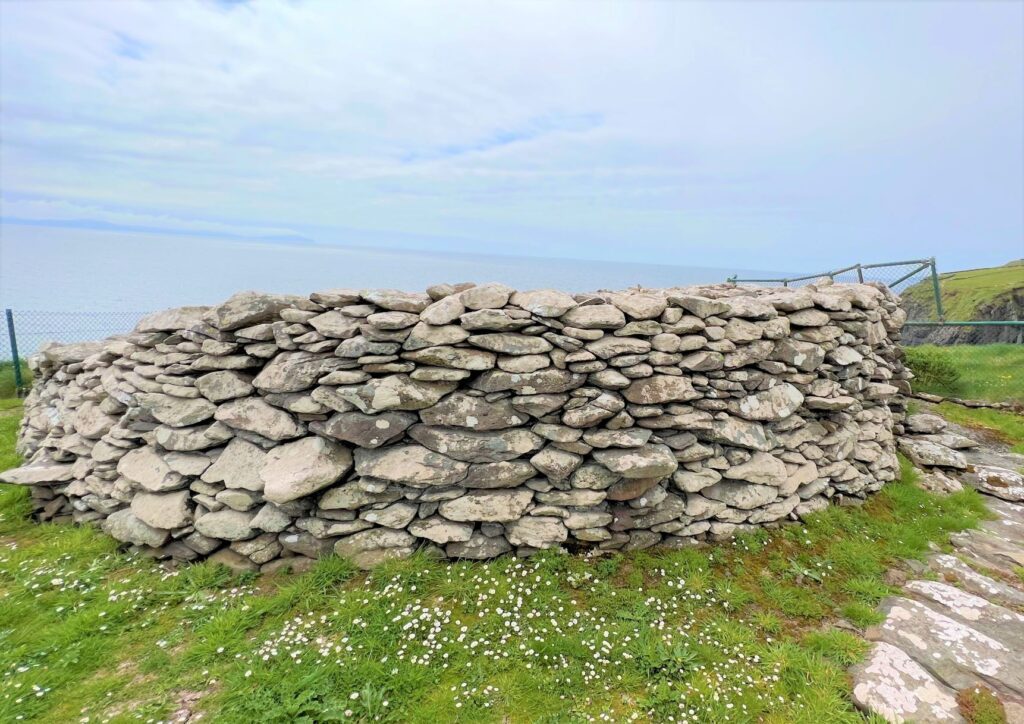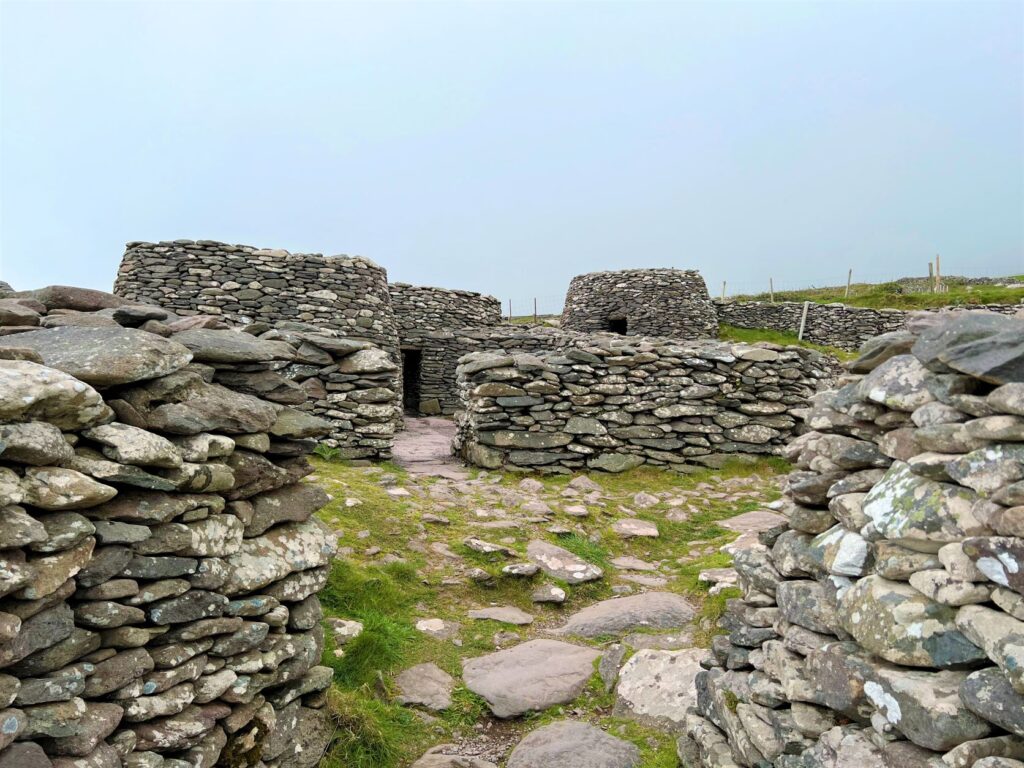
Located on Ireland’s westernmost point, the Dingle Peninsula juts out into the Atlantic Ocean and offers tremendous views, prehistoric sites, and Gaelic culture. While most tourists add the nearby Ring of Kerry to their itineraries, you should definitely consider going to the Dingle Peninsula instead or in addition to. In my opinion, the Dingle Peninsula offers better scenery and more interesting ancient sites. Perhaps most importantly, it is much less crowded which will always make for a better experience!
Note: we may earn a commission from the affiliate links below.

Dingle Peninsula One-Day Itinerary
Now that I’ve convinced you to add the Dingle Peninsula to your itinerary, here all the things you must see and do while traveling it! Tourists usually start and end in the city of Killarney where you can find many lodging options. You can explore it via self-drive, private tour, or group tour. You can also find lodging in Dingle and self-drive or book a private tour or group tour from there. If you have plenty of time to spend in Ireland, I highly recommend the latter as the town of Dingle is adorable and spending a night or two there is an ideal way to really soak in the unique culture of the area.
Start your exploration of the peninsula by driving clockwise on Slea Head Drive from Dingle. This 24 mile circular route is part of the Wild Atlantic Way and is one of Ireland’s most scenic drives. I’m covering my favorite places to stop below, but know that every minute of the journey has awe-inspiring scenery.

Ventry Beach
The Dingle Peninsula is full of beautiful beaches. Ventry Beach is a great one to visit as it’s light on crowds and features a long sandy beach and a pier with great views of the bay. It’s a great place for a quick photo stop, a walk along the ocean, or even a beach day if you have more time.

Dún Beag Fort
Dún Beag Fort dates from the Iron age and perches on a cliff offering panoramic views of the Atlantic Ocean. There’s a visitor’s center on site with exhibits, a cafe, and a craft shop. Sadly, it’s location on a cliff means that it won’t be with us much longer – erosion will take its toll.

Caher Conor Beehive Huts
Another not-to-be-missed site is the Caher Conor Beehive Huts. These ancient stone domes were used by monks and early settlers. Experts disagree on their exact age, dating them from the 8th to 12th century. These amazing structures are constructed without mortar. The stones are stacked on top of each other in a corbelling method with each layer being slightly further inward to create the dome structure.

Cross at Slea Head
The Cross at Slea Head is a striking monument of Jesus on the cross with a statue of the Virgin Mary nearby. The views from this site are equally striking, with cliffs, crashing waves, and gorgeous ocean views.

Views of the Blasket Islands
All along this stretch are other gorgeous views of the coastline, rugged cliffs, and the Blasket Islands out in the distance. Great places to stop include the Radharc na mBlascaoidí viewpoint, and the Ceann Sibéal viewpoint.

Dunquin Pier
Admire the winding, zig-zag path down to the Dunquin Pier from above. Or if you are feeling energetic, take the path all the way down. This is the pier where ferries take people out to the Blasket Islands. This is an option if you are traveling mid-April to mid-September and have more than one day to spend in the area.

Blasket Center
This award winning cultural center describes the lives of the Blasket Islanders. These people lived on the remote Blasket Islands from the late 16th century until the last citizens left in 1953. The Blasket Center uses exhibits, interactive displays, artifacts, and audio-visual presentations to describe the islanders lives. These hearty people lived on subsistence fishing and farming. You will walk away with a greater understanding of their work, what their homes looked like, and how they lived day-to-day.

Gallarus Oratory
At over 1,000 years old, Gallarus Oratory is a wonderfully preserved early Christian church. Like the beehive structures nearby, this church is made entirely of stone without mortar. Amazingly, it’s construction is so sound that it’s still waterproof after all of these years!

Kilmalkedar Church
Another must-see church on the Dingle Peninsula is Kilmalkedar Church. Dating from the 12th century, the church features Romanesque architecture. It was once the site of an important monastic settlement and was a stop an ancient pilgrimage route to Mount Brandon. Surrounding the church are several interesting ruins and artifacts. There’s the ruins of a priest’s house, a historic graveyard, a sundial, and a stone cross. There’s also an Ogham stone featuring early Irish writing and a stone that has the letters DNI (short for Domini, which is Latin for Lord) known as the alphabet stone.

Conor Pass
If you are self-driving or on a private tour, you can add a drive on Conor Pass to your day. The 7.5 mile twisting narrow road offers amazing views of glacial lakes, coast lines, and rolling valleys. The road is so narrow at some points that cars can’t pass each other. If you are self-driving, know that it’s not for the faint of heart!

Dingle Town
The town of Dingle is a charming harbor village that definitely deserves a lingering stop. You are likely to be hungry, and there’s plenty of good eats in town. Feast on fresh seafood, or enjoy some traditional Irish food at one of the pubs. Interestingly, several of the pubs are also hardware stores! If you are visiting in the evening, the pubs might be hosting live traditional Irish music. No matter what you eat for your meal, dessert must be Murphy’s Ice Cream. My favorite flavors include sea salt (made with salt from the nearby Dingle Bay) and caramel honeycomb, but Irish brown bread and Dingle gin are also popular.
Wander around the Dingle harbor and admire the cute statue of Fungie the dolphin. For 38 years, Fungie made his home in the Dingle harbor and interacted with locals. While Fungie no longer appears in the harbor, you might see other dolphins as well as a great view of the scenery on a boat tour.
Other interesting sites in Dingle include St. Mary’s Church, An Deisert (The Dingle Sacred Heart Cultural Centre), the Dingle Oceanworld Aquarium, and the Dingle Distillery. Dingle’s assortment of galleries and artisan shops also make it a great place to buy souvenirs.
As you wander around town, you will start understanding what makes the Dingle Peninsula so unique. You probably have noticed that all of the road signs in the area are written in Gaelic. And in town, you’ll routinely hear the locals speaking that language as well. The entire experience makes you feel like you stepped back in time and are truly discovering the “real” Ireland.
What’s on your Dingle Peninsula itinerary?
Tell us below! You can also contact us and follow us on Facebook, Instagram and Pinterest so you never miss a post!



Pingback: Which is Better: Ring of Kerry vs. Dingle Peninsula? - Extravelgance
Pingback: Wonderful Sites to See Along the Wild Atlantic Way - Extravelgance
Pingback: 8 Enchanting Days in the Emerald Isle - Extravelgance